November 2, 2014 at 8:31 pm
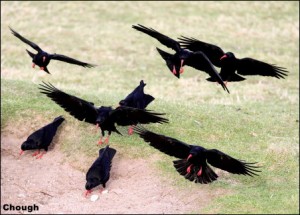
Our 100th visit to Islay since 1976 and by far the worst October weather we have ever had. Only two dry days in eight but on Islay there is always good bird-watching to be had despite the horizontal rain!
The Geese and Whooper Swans are always impressive but what was impressive on this visit were the thousands of Redwings on the island but no Fieldfares to be found, due no doubt to the continuously strong westerly winds.Back home House Sparrows are in decline but on Islay they are everywhere – we even had 33 around one feeder in the garden where we were staying.
On the best day we crossed to Jura and found an Otter plus 15 Turnstones along the shore. As usual Red Deer were everywhere and we even found an enormous toadstool. A superb male Merlin was seen to catch a Pipit and take it onto a stump to eat. He was extremely wary but I managed to obtain a record shot of him by hand holding a large lens on the side of the car.
One of the highlights of the week was seeing a flock of 68 Chough, the largest we have ever seen on Islay. Supplementary feeding of the young Chough is helping the juvenile birds survive their first Winter and the benefits are already beginning to show.
We cant wait to return next year! For photos of our visit Click here
October 26, 2014 at 2:12 pm
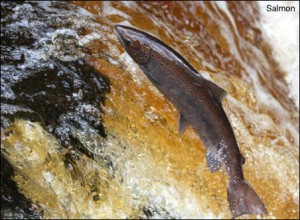
After a visit to the Ribble at Settle a fortnight ago and no signs of any salmon I thought I would not be returning again this Autumn. However, a meeting with a fellow salmon enthusiast was to change all that after he telephoned me early one day last week to say that there were many salmon jumping the falls. When I sat beside the falls two hours later little did I know that I would not leave that spot for four hours!
Filming salmon is anything but easy. Firstly your camera will not focus on the falling water. Secondly you have no idea when and from what direction the salmon will appear. Thirdly you only have a split second to press the shutter so all in all there is a lot of wastage. This is borne out by the fact that out of 550 photos I took I have retained only 20! It was however a magical experience to sit within feet of these long distance travellers as they tried to reach the very spot where they were born. Click here
October 19, 2014 at 12:31 pm
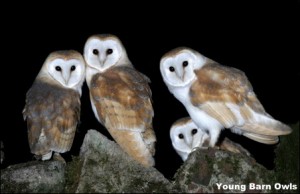
Will there ever be another breeding season like this one with young House Martins still in the nest in October and two broods of Barn Owls still in their nesting barn?
When you spend many hours observing and filming a species sometimes something happens that has never been recorded before let alone captured on film. This is exactly what happened with the Barn Owls. For six weeks only the male Barn Owl was feeding the seven young and at times he was only just coping with their ever increasing demands for food. One night when some of the young were on the wall outside the barn an older young flew in to them with a vole in its bill. It stood there for a minute as the young were looking the other way. Suddenly one young realised that the young was offering prey to it and then grabbed and swallowed the prey offered. I had little doubt that one of the young had learned how to catch prey and was responding to the hunger calls of its sibling and providing food. Has this ever been witnessed before? Click here
October 12, 2014 at 5:05 pm
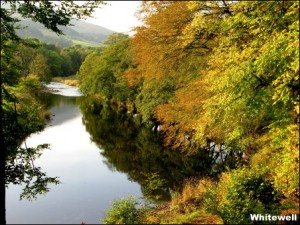
The colours of Autumn are shown no better than in the river systems of the Pennines and my favourite place is Whitewell in the Forest of Bowland. This weeks photo is one I take every year but never tire of the perfect setting and colours.
Migration is now well underway with the first garden Goldcrest appearing on the 7th October. Three days earlier a Redwing passed over as more Skylarks were on the move. In contrast eight House Martins were still present locally and left with the last of the warm weather.
The numbers of Salmon entering British rivers this year is extremely low and this was borne out by my visit to the river Ribble at Settle on the 10th. Not one was seen, it would have been a wasted journey but for a fly past of a Kingfisher.
Local foxes are now becoming more nocturnal as the woodland cover begins to die away. Only their droppings indicate an overnight presence. Click here
October 5, 2014 at 5:59 pm
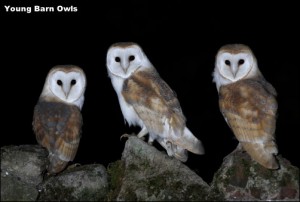
Once a bird has fledged the nest it is almost impossible to catch up with in the wild and there is little chance of ever filming it being fed by the adults. This difficulty is greatly enhanced with raptors whose young are continually on the move and wary subjects.
An opportunity arose in August to go for some more challenging photos of young Barn Owls after they had left the nest, when my regular pair had a second brood of five young. I noticed that each evening when the young left the barn they would alight on a dry-stone wall nearby and were sometimes fed on this wall by the male. This is the photo I wanted so I placed my hide opposite the wall and in the next four weeks spent twenty one nights hoping for an opportunity to film the food pass. There were many occasions in the pitch black when I could not see whether the young were looking at me or away from me but I persevered and finally achieved the shots I was after. When you look at the gallery the adult male owl is the bird with the darker facial disk. Click here The prey consisted of voles, rats and mice. I hope you enjoy the group shots of what was a remarkable session in perfect conditions.
September 28, 2014 at 8:23 pm
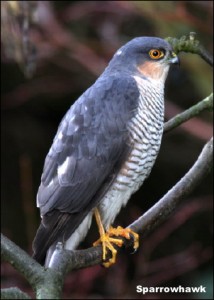 During the week not one but two male Sparrowhawks were chasing each other across the garden only a couple of feet apart. One returned on the 27th to catch a male Greenfinch which is always a sad event to witness but even raptors have to survive, preferably not in our garden. click here.
During the week not one but two male Sparrowhawks were chasing each other across the garden only a couple of feet apart. One returned on the 27th to catch a male Greenfinch which is always a sad event to witness but even raptors have to survive, preferably not in our garden. click here.
On the main road the House Martins finally fledged their young on the 28th September, being the second latest date I have ever known.
Over Hopwood this week there has been a passage of Skylarks with two still singing as they headed South West on the 22nd. Two Green Woodpeckers were present plus Chiff Chaffs and a very late male Whitethroat. After a gap of many months I located my first Long Tailed Tits but where are all the others?
Two days spent at Gleneagles watching the Ryder Cup also found birds. Thousands of PInk Footed geese were present in the surrounding fields and at the Westmorland Services on the way home fifty plus Pied Wagtails were going to roost in a single Rowan tree.







 During the week not one but two male Sparrowhawks were chasing each other across the garden only a couple of feet apart. One returned on the 27th to catch a male Greenfinch which is always a sad event to witness but even raptors have to survive, preferably not in our garden.
During the week not one but two male Sparrowhawks were chasing each other across the garden only a couple of feet apart. One returned on the 27th to catch a male Greenfinch which is always a sad event to witness but even raptors have to survive, preferably not in our garden.